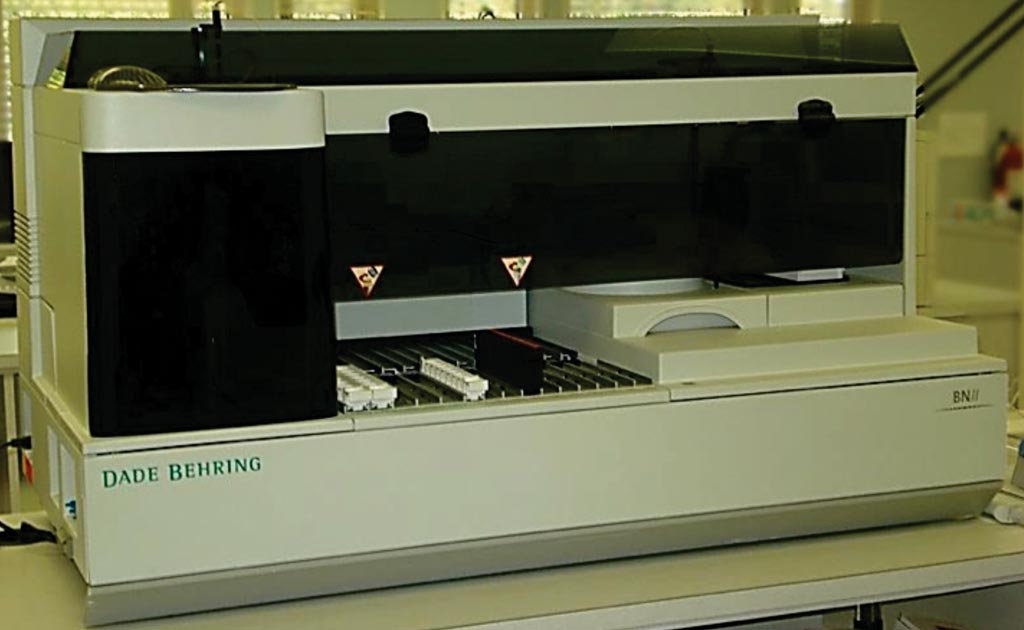Low Levels of Klothos Linked to Kidney Function Decline
|
By LabMedica International staff writers Posted on 15 Feb 2017 |

Image: The Dade Behring BN II automated nephelometer system (Photo courtesy of Siemens Healthcare).
The kidney has the highest levels of klotho expression and is likely the major source of soluble klotho and not surprisingly, therefore, levels of klotho tend to be low in patients with kidney disease.
Soluble klotho is a protein circulating in the blood that is thought to have anti-aging properties and although the exact mechanism of action of soluble klotho remains to be identified, the protein has been shown to influence multiple cellular and endocrine pathways.
A large team of scientists led by those at Tufts Medical Center carried out a prospective cohort initiated in 1997 with a goal of assessing how health conditions affect age-related physiologic and functional status. The study population consists of 3,075 persons aged 70 to 79 years at baseline with equal numbers of men and women and approximately one third African-Americans. All 2,496 participants who had measures of klotho and kidney function at baseline, and at least one repeat measure of kidney function were included in this study.
Serum soluble α-klotho was assayed using a commercially available sandwich enzyme-linked immunosorbent assay (ELISA) test from never-thawed frozen serum stored at -70 °C and obtained at the year two visit, approximately one year after the baseline visit. This assay is reported to have a sensitivity of 6.15 pg/mL, and demonstrated an interassay coefficient of 18%. The associations between soluble klotho levels and decline in kidney function and incident chronic kidney disease (CKD) were evaluated. Cystatin C was measured at baseline, as well as years three and 10, from stored frozen serum samples using a BNII nephelometer and an N Latex Cystatin C particle-enhanced immunonephelometric assay.
The scientists found that the median (25th, 75th percentiles) klotho level was 630 (477, 817) pg/mL. In fully adjusted models, each two-fold higher level of klotho associated with lower odds of decline in kidney function (odds ratio, 0.78) for 30% decline in estimated glomerular filtration rate (eGFR), and 0.85 for greater than 3 mL/min per year decline in eGFR, but not of incident CKD (incident rate ratio, 0.90). Overall, a higher soluble klotho level independently associated with a lower risk of decline in kidney function.
David A. Drew, MD, MS, the lead author of the study, said, “We found a strong association between low soluble klotho and decline in kidney function, independent of many known risk factors for kidney function decline. This suggests that klotho could play a role in the development of chronic kidney disease, although additional studies will need to confirm this. This also raises the possibility that klotho could be an important therapeutic target for future clinical trials.” The study was published on January 19, 2017, in the Journal of the American Society of Nephrology.
Soluble klotho is a protein circulating in the blood that is thought to have anti-aging properties and although the exact mechanism of action of soluble klotho remains to be identified, the protein has been shown to influence multiple cellular and endocrine pathways.
A large team of scientists led by those at Tufts Medical Center carried out a prospective cohort initiated in 1997 with a goal of assessing how health conditions affect age-related physiologic and functional status. The study population consists of 3,075 persons aged 70 to 79 years at baseline with equal numbers of men and women and approximately one third African-Americans. All 2,496 participants who had measures of klotho and kidney function at baseline, and at least one repeat measure of kidney function were included in this study.
Serum soluble α-klotho was assayed using a commercially available sandwich enzyme-linked immunosorbent assay (ELISA) test from never-thawed frozen serum stored at -70 °C and obtained at the year two visit, approximately one year after the baseline visit. This assay is reported to have a sensitivity of 6.15 pg/mL, and demonstrated an interassay coefficient of 18%. The associations between soluble klotho levels and decline in kidney function and incident chronic kidney disease (CKD) were evaluated. Cystatin C was measured at baseline, as well as years three and 10, from stored frozen serum samples using a BNII nephelometer and an N Latex Cystatin C particle-enhanced immunonephelometric assay.
The scientists found that the median (25th, 75th percentiles) klotho level was 630 (477, 817) pg/mL. In fully adjusted models, each two-fold higher level of klotho associated with lower odds of decline in kidney function (odds ratio, 0.78) for 30% decline in estimated glomerular filtration rate (eGFR), and 0.85 for greater than 3 mL/min per year decline in eGFR, but not of incident CKD (incident rate ratio, 0.90). Overall, a higher soluble klotho level independently associated with a lower risk of decline in kidney function.
David A. Drew, MD, MS, the lead author of the study, said, “We found a strong association between low soluble klotho and decline in kidney function, independent of many known risk factors for kidney function decline. This suggests that klotho could play a role in the development of chronic kidney disease, although additional studies will need to confirm this. This also raises the possibility that klotho could be an important therapeutic target for future clinical trials.” The study was published on January 19, 2017, in the Journal of the American Society of Nephrology.
Latest Clinical Chem. News
- Chemical Imaging Probe Could Track and Treat Prostate Cancer
- Mismatch Between Two Common Kidney Function Tests Indicates Serious Health Problems
- VOCs Show Promise for Early Multi-Cancer Detection
- Portable Raman Spectroscopy Offers Cost-Effective Kidney Disease Diagnosis at POC
- Gold Nanoparticles to Improve Accuracy of Ovarian Cancer Diagnosis
- Simultaneous Cell Isolation Technology Improves Cancer Diagnostic Accuracy
- Simple Non-Invasive Hair-Based Test Could Speed ALS Diagnosis
- Paper Strip Saliva Test Detects Elevated Uric Acid Levels Without Blood Draws
- Prostate Cancer Markers Based on Chemical Make-Up of Calcifications to Speed Up Detection
- Breath Test Could Help Detect Blood Cancers
- ML-Powered Gas Sensors to Detect Pathogens and AMR at POC
- Saliva-Based Cancer Detection Technology Eliminates Need for Complex Sample Preparation
- Skin Swabs Could Detect Parkinson’s Years Before Symptoms Appear
- New Clinical Chemistry Analyzer Designed to Meet Growing Demands of Modern Labs

- New Reference Measurement Procedure Standardizes Nucleic Acid Amplification Test Results
- Pen-Like Tool Quickly and Non-Invasively Detects Opioids from Skin
Channels
Molecular Diagnostics
view channel
Blood Test Enables Non-Invasive Endometriosis Detection
Endometriosis is a chronic, complex, yet relatively common gynecological disorder, reportedly affecting 1 in 10 adult and adolescent women. Endometriosis causes tissue similar to the lining of the uterus... Read more
New Blood Biomarkers Help Diagnose Pregnancy-Linked Liver Complication
Intrahepatic cholestasis of pregnancy (ICP) is the most common liver disorder linked to pregnancy and can pose serious risks for both mother and baby, including premature delivery and stillbirth.... Read moreHematology
view channel
MRD Tests Could Predict Survival in Leukemia Patients
Acute myeloid leukemia is an aggressive blood cancer that disrupts normal blood cell production and often relapses even after intensive treatment. Clinicians currently lack early, reliable markers to predict... Read more
Platelet Activity Blood Test in Middle Age Could Identify Early Alzheimer’s Risk
Early detection of Alzheimer’s disease remains one of the biggest unmet needs in neurology, particularly because the biological changes underlying the disorder begin decades before memory symptoms appear.... Read more
Microvesicles Measurement Could Detect Vascular Injury in Sickle Cell Disease Patients
Assessing disease severity in sickle cell disease (SCD) remains challenging, especially when trying to predict hemolysis, vascular injury, and risk of complications such as vaso-occlusive crises.... Read more
ADLM’s New Coagulation Testing Guidance to Improve Care for Patients on Blood Thinners
Direct oral anticoagulants (DOACs) are one of the most common types of blood thinners. Patients take them to prevent a host of complications that could arise from blood clotting, including stroke, deep... Read moreImmunology
view channel
Routine Blood Test Can Predict Who Benefits Most from CAR T-Cell Therapy
CAR T-cell therapy has transformed treatment for patients with relapsed or treatment-resistant non-Hodgkin lymphoma, but many patients eventually relapse despite an initial response. Clinicians currently... Read more
New Test Distinguishes Vaccine-Induced False Positives from Active HIV Infection
Since HIV was identified in 1983, more than 91 million people have contracted the virus, and over 44 million have died from related causes. Today, nearly 40 million individuals worldwide live with HIV-1,... Read more
Gene Signature Test Predicts Response to Key Breast Cancer Treatment
DK4/6 inhibitors paired with hormone therapy have become a cornerstone treatment for advanced HR+/HER2– breast cancer, slowing tumor growth by blocking key proteins that drive cell division.... Read more
Chip Captures Cancer Cells from Blood to Help Select Right Breast Cancer Treatment
Ductal carcinoma in situ (DCIS) accounts for about a quarter of all breast cancer cases and generally carries a good prognosis. This non-invasive form of the disease may or may not become life-threatening.... Read moreMicrobiology
view channel
Blood-Based Diagnostic Method Could Identify Pediatric LRTIs
Lower-respiratory tract infections (LRTIs) are a leading cause of illness and death worldwide, and pneumonia is the leading infectious cause of death in children under five, claiming the lives of over... Read more
Rapid Diagnostic Test Matches Gold Standard for Sepsis Detection
Sepsis kills 11 million people worldwide every year and generates massive healthcare costs. In the USA and Europe alone, sepsis accounts for USD 100 billion in annual hospitalization expenses.... Read moreRapid POC Tuberculosis Test Provides Results Within 15 Minutes
Tuberculosis remains one of the world’s deadliest infectious diseases, and reducing new cases depends on identifying individuals with latent infection before it progresses. Current diagnostic tools often... Read more
Rapid Assay Identifies Bloodstream Infection Pathogens Directly from Patient Samples
Bloodstream infections in sepsis progress quickly and demand rapid, precise diagnosis. Current blood-culture methods often take one to five days to identify the pathogen, leaving clinicians to treat blindly... Read morePathology
view channel
Rapid Low-Cost Tests Can Prevent Child Deaths from Contaminated Medicinal Syrups
Medicinal syrups contaminated with toxic chemicals have caused the deaths of hundreds of children worldwide, exposing a critical gap in how these products are tested before reaching patients.... Read more
Tumor Signals in Saliva and Blood Enable Non-Invasive Monitoring of Head and Neck Cancer
Head and neck cancers are among the most aggressive malignancies worldwide, with nearly 900,000 new cases diagnosed each year. Monitoring these cancers for recurrence or relapse typically relies on tissue... Read more
Common Health Issues Can Influence New Blood Tests for Alzheimer’s Disease
Blood-based tests for Alzheimer’s disease are transforming diagnosis by offering a simpler alternative to spinal taps and brain imaging. However, many people evaluated at memory clinics also live with... Read more
Blood Test Formula Identifies Chronic Liver Disease Patients with Higher Cancer Risk
Chronic liver disease affects millions worldwide and can progress silently to hepatocellular carcinoma (HCC), one of the deadliest cancers globally. While surveillance guidelines exist for patients with... Read moreTechnology
view channel
Artificial Intelligence Model Could Accelerate Rare Disease Diagnosis
Identifying which genetic variants actually cause disease remains one of the biggest challenges in genomic medicine. Each person carries tens of thousands of DNA changes, yet only a few meaningfully alter... Read more
AI Saliva Sensor Enables Early Detection of Head and Neck Cancer
Early detection of head and neck cancer remains difficult because the disease produces few or no symptoms in its earliest stages, and lesions often lie deep within the head or neck, where biopsy or endoscopy... Read moreIndustry
view channel
Abbott Acquires Cancer-Screening Company Exact Sciences
Abbott (Abbott Park, IL, USA) has entered into a definitive agreement to acquire Exact Sciences (Madison, WI, USA), enabling it to enter and lead in fast-growing cancer diagnostics segments.... Read more

















